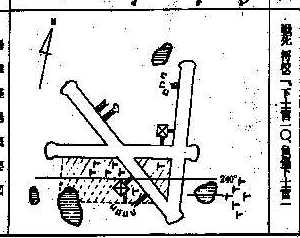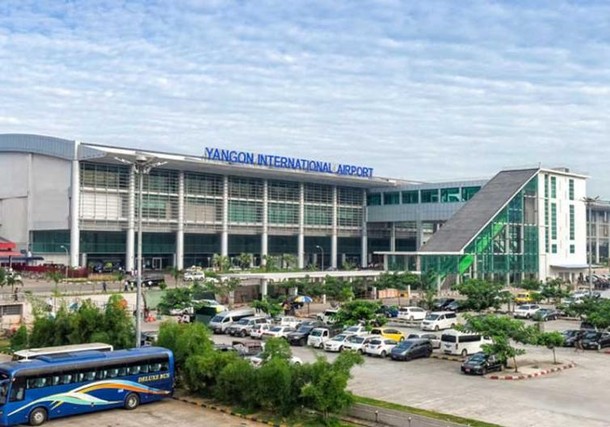L'areoporto di Mingaladon - Myouth - Ricordi degli anni '70
Menu principale:
L'areoporto di Mingaladon
Modellismo > Aerei > Nakajima Ki-43 II
La base aerea di Mingaladon
Yangon (Mingaladon) Airport
Yangon International Airport (IATA: RGN, ICAO: VYYY) is the primary and busiest international airport of Myanmar. The airport is located in Mingaladon, 15 kilometres (9.3 mi) north of central Yangon. All ten Myanmar carriers and about 30 international airlines operate at Yangon International Airport. The airport is also colloquially known as Mingaladon Airport due to its location.
History
During World War II, the airfield was called RAF Mingaladon and served as an operating base for fighter aircraft such as:
- No. 60 Squadron RAF from February 1941 to February 1942 flying Bristol Blenheim I
- No. 67 Squadron RAF from October 1941 to March 1942 flying Brewster F2A Buffalo and Hawker Hurricane IIs
- No. 135 Squadron RAF from January–February 1942 flying Hawker Hurricane IIs
- No. 681 Squadron RAF from June to September 1945 flying Supermarine Spitfire
- 3rd Squadron of 1st American Volunteer Group (Flying Tigers) of the Chinese Air Force flying Curtiss P-40s
There was also a Communication Flight of the Burma Volunteer Air Force equipped with Tiger Moths and Westland Lysanders and anti-aircraft support for the airfield was provided by members of the 12th Burma Rifles.
Mingaladon was then used by the Japanese, and Japanese bombers based in Bangkok were moved forward to Mingaladon when there was a full moon. The British at the Wireless Experimental Centre in Delhi were breaking BULBUL the IJA air-to-ground code, and could predict Japanese air raids. On one occasion Allied nightfighters "got the lot and all night we could hear Mingaladon air base calling for its lost children".
Additional units;
- Air Headquarters Burma Communication Squadron RAF
- Air Headquarters Burma Communication Flight RAF
- Air Headquarters Netherlands East Indies Communication Squadron RAF
- No. 221 Group Communication Squadron RAF
After World War II, Yangon Airport was built on the former RAF Mingaladon in 1947 by the Calcutta Metropolitan Airports Authority. Once regarded as the best in Southeast Asia and the primary airport serving that region, the airport fell into disrepair and remained that way for decades, as new superhubs like Singapore Changi Airport, Bangkok Suvarnabhumi Airport and Jakarta Soekarno-Hatta were built and superseded Yangon's facilities.
Airport capacity was boosted to 6 million passengers per year in early 2016. Currently, there are plans to build a completely new and larger airport, Hanthawaddy International Airport, on a much larger site and somewhat away from Yangon.
Modernization
A modernization program was launched in April 2003 and resulted in a new terminal and an extended 3414 m runway.
Designed by the Airport Development Division of CPG Corporation of Singapore, a new terminal was constructed at a cost of US$13.3 million by Asia World. It can handle 900 arriving and 900 departing passengers simultaneously. The design meets IATA service standards and complies with ICAO safety and security standards at a cost of SG$30 million. Other notable features include:
- Separate floors for arriving and departing passengers to lessen congestion
- Automated baggage handling system with an integrated check-in system
- Four air bridges, capable of handling four Boeing 747s
- Special lounges for use by government officials and business people
- A two-story parking garage with spaces for 340 vehicles
In June 2011, the government announced plans to expand the airport by 40% and increase its capacity from 2.7 million passengers to 3.8 million passengers annually. The airport was already over its annual capacity of 2.7 million passengers, having accepted 3.1 million in 2012 and 4 million in 2014. To fulfill this increased demand, new international and domestic terminals are being constructed and are expected to be finished end of 2016. After upgrading, Yangon International Airport will be able to service 6 million passengers annually.
In 2013, a contract worth $150 million was awarded to a consortium led by an affiliate of Asia World to construct a new domestic terminal and expansion of airport apron.
The new international terminal (T1) opened in March 2016, with the previously existing international terminal being designated as T2. The new domestic terminal (T3) opened on December 5, 2016.
Source: Wikipedia
Mingaladon AAir Base (47 08 10 N – 18 30 00 E)
Riporto integralmente un articolo di Daniel Ford pubblicato sul sito warbirdforum.com
The layout of Mingaladon Airport, Rangoon
 This file began when a Flight Simmer asked me about the layout of Mingaladon airport in 1941-42. Here's the best answer I could find, from the appendix of Erik Shilling's autobiography. It is based on a 1942 CAMCO diagram of the airport outside Rangoon, complete with the final assembly and test area to the south (the hoist, "mat sheds," and two-plane hangar). This diagram first appeared in Flying magazine, illustrating an article by Byron Glover. I've added the runway designators from Erik's description of his stint at Mingaladon in December 1941. He says that AVG Tomahawks took off from 06 and 12 while the RAF took off from 36. What fun!
This file began when a Flight Simmer asked me about the layout of Mingaladon airport in 1941-42. Here's the best answer I could find, from the appendix of Erik Shilling's autobiography. It is based on a 1942 CAMCO diagram of the airport outside Rangoon, complete with the final assembly and test area to the south (the hoist, "mat sheds," and two-plane hangar). This diagram first appeared in Flying magazine, illustrating an article by Byron Glover. I've added the runway designators from Erik's description of his stint at Mingaladon in December 1941. He says that AVG Tomahawks took off from 06 and 12 while the RAF took off from 36. What fun! 
Later, Matt Poole contributed a British sketch map of Mingaladon made from a photo-reconnaissance mission in May 1943, before the Japanese lengthened the east-west runway. Some of the dispersal areas were likely built by the Japanese after they occupied the airport in February 1942. On documents Matt found at the Public Records Office near London, runway 06/24 is shown as 3960 feet "between turning circles." Runway 12/30 is 3750 ft, and Runway 35/18 is 4200 ft. (Toward the end of the war, the Japanese lengthened 12/30 to the west, actually crossing the Rangoon-Pegu Road. It was this longer runway that I mistakenly described in the first edition of my history of the AVG.)

By way of comparison, here's a Japanese sketch of Mingaladon as revealed by reconnaissance photographs in December 1941. Thirteen crossmarks show where RAF and AVG aircraft were dispersed when the photo plane went over. The sketch was published in a semi-official Japanese history of the air war in Southeast Asia.
Source: warbirdforum.com
Il sito World of Warplanes pubblica un articolo molto interessante riguardo l'attività degli Alleati a Mingaladon
Home Page | Modellismo | Topolini | Altri Disney | Linus | Asterix | Diabolik | Giornalini di guerra | Western | Riviste | Romanzi | Mappa generale del sito




